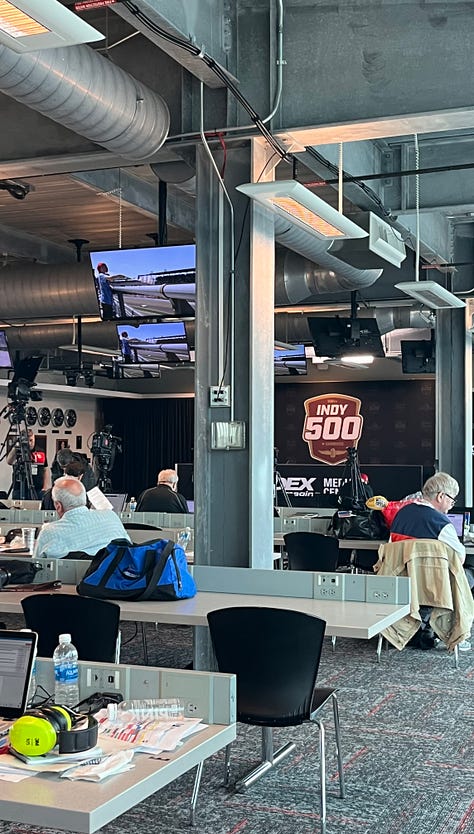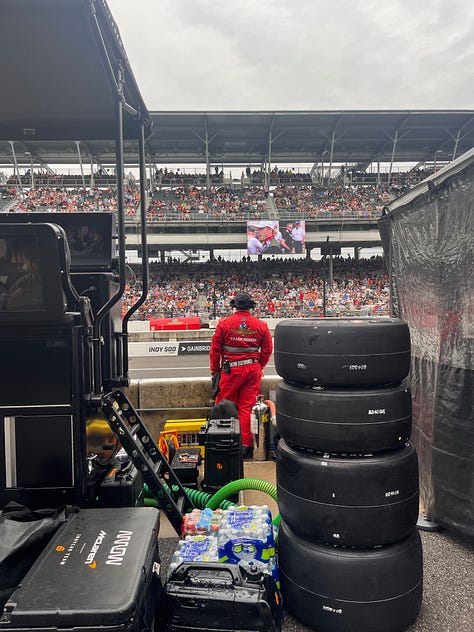When a Sports Spoof Account Turns Into Fake News
Plus: The biggest weekend in motor racing
Welcome to The Undercut, a weekly newsletter round-up of the top storylines in racing brought to you by your favorite motorsport and enviro journo, Olivia Hicks. If you’re wondering “What the f*** is Formula 1?” Ask away! Leave a comment or send me a message with your burning questions.
When a Sports Spoof Account Turns Into Fake News: The Alpine Drama and the Deterioration of Fact-Checking
On Monday, Alpine F1 Team posted a statement on social media reading “As an F1 team, we believe we are fortunate to be a part of a global sport that evokes great passion and emotions, with an ever-growing community of fans who enthusiastically follow their favorite drivers’ every move, whether it be a brave overtake on track or what style they are sporting when they arrive in the paddock.
“We encourage everyone to remember that behind the visor of these superhuman athletes, there is a person. An individual with feelings, family, friends and loved ones. As a team, we cannot condone online abuse and urge all fans of this sport we love to be kind and respectful.”
The cryptic message followed a post by FormulaFakers, a popular social media account that publishes comedic fake news about the sport, that depicted former Alpine driver Jack Doohan’s father criticizing Argentine driver Franco Colapinto’s crash during the Emilia Romagna Grand Prix qualifying session. Last weekend was Colapinto’s first race back in Formula 1 after replacing Doohan.
The tweet read “Mick Doohan in a now-deleted Instagram story” with a photoshopped image of Doohan’s father commenting on the crash. The post, which has since been taken down, reached two million accounts. Argentine media circulated the post, failing to fact-check whether it was real, and Colapinto fans took to social media to skewer the Doohans.
Following Alpine’s statement — which Colapinto reposted — Doohan criticized the original account for “attempting to portray me and my family in a negative night. They edited the original content to make it appear as though my father posted it, which is entirely untrue. Please stop harassing my family. I didn’t think I would have to get to this point.”
FormulaFakers started as a spin on FormulaRacers, a news and analysis account with over 350,000 followers on X (formerly Twitter). Acting as Formula 1’s very own The Onion, the account posted jokes for those in the know (i.e. the sport’s chronically online fanbase) and most photoshopped parody posts were easy to spot as exactly that. However, the account logo’s likeness to a trusted source, paired with the Formula 1 news cycle’s tendency to rely heavily on paddock-circulated rumors, created occasional bouts of confusion.
The line between real and fake blurred even more last month when Formula 1 news accounts hopped on the spoof trend on April Fools Day, with publications like The Race, Motorsport.com and ESPN mimicking FormulaFakers by publishing fake Formula 1 news on social media for the day.
Sports news social media accounts have occupied an uncomfortable space online in recent years, juggling a professional identity with a less buttoned-up one by appealing to young people via social media who already trust influencers and celebrities more than journalists and experts. For most, it has worked well to have a twenty-something behind the lens creating viral TikTok videos or in the comment section using fandom-speak. From big corporations to local businesses, airlines (most notably RyanAir) to online language learning platforms (Duolingo) and Formula 1 teams to national news outlets, adopting a casual, cool tone makes these companies likable. And hopping on trends is part of that charm.
But social media’s rapid trend cycle and ability to spread information with the press of a button doesn’t encourage fact-checking. For trusted outlets, when does journalistic integrity slip through the cracks of a joke or a trend? While the April Fools posts were a harmless, easily-spottable prank on one day of the year and FormulaFakers is just a humorous X account, both say a lot about the current state of fact-checking, social media journalism and how we define credibility.
In January, Meta ended fact-checking functions on Facebook and Instagram. In April, TikTok joined Meta and X in handing over fact-checking to users, via crowdsourcing information, rather than employing professionals. Most social media platforms have switched to a community note format after censorship complaints. And while allowing users with four WiFi bars to vote on the truth has sometimes brought a discussion-based approach to social media and aided fact-checking (like racing fanatics pointing out my poor math skills in the comment section of a recent column), it has also often met misinformation with more misinformation.
Ahead of the Monaco Grand Prix, Formula 1 urged social media platforms to police “online abuse.” Several Formula 1 news outlets have churned out think pieces unpacking toxic tribalism in the sport following the FormulaFakers post. However, the incident seems to have less to do with cyberbullying and more to do with media literacy, or lack thereof.
The Biggest Weekend in Motorsport: The Monaco Grand Prix and the Indy 500



This time last year, I sat in the press box overlooking the Indianapolis Motor Speedway. If you’re looking to attend the largest non-religious gathering of humans on earth, I recommend straying from my schedule. Don’t pick up your press pass the day of the race, don’t double-fist an energy drink and iced coffee at 5:30 a.m. and don’t assume parking will be a breeze. I’m sure all of those guidelines apply to the Monaco Grand Prix as well.
On the biggest weekend in motorsport, the two most-anticipated races of the calendar year couldn’t be more different. One is defined by trackside yacht parties, crisp white linen and people who are professionally beautiful for a living. The other is a peek into Americana: trash bins overflowing with crushed Coors Light cans, cut-off jean shorts and camper vans. Yet both have a sacred place in the heart of motor racing. The city of Indianapolis lives and breathes motorsport and seems to have a one-track mind: The Indy 500. Pink boutiques sell hats, coffee mugs and t-shirts at the oddly specific intersection of Taylor Swift and IndyCar references. The city’s streets are renamed after drivers. And every few houses, a checkered flag flies. Monaco, for all its European differences, has a similar loyalty toward the sport. A sculpture of a vintage Formula 1 car sits harborside and €10 buys an up-close look at a modern race car at the prince’s car collection. In both cities, drivers can largely go about their everyday lives unbothered.
Known as the “Crown Jewel” of motorsport and the “Greatest Spectacle in Racing,” both events and their potential for a first-time winner — the pair of McLarens are favorites with a strong pace and rookie Prema Racing driver Robert Shwartzman will start on pole for the Indy 500 — promise the unexpected.
But one is overshadowed by cheating allegations. Team Penske parted ways with three senior leaders on Wednesday, including IndyCar Series and Indianapolis Motor Speedway owner Roger Penske. Two Penske cars, Josef Newgarden’s No. 2 and Will Power’s No. 12, will start at the back of the grid following illegal alterations to the cars. Each driver’s crew was ordered to pay a $100,000 fine and both were stripped of qualifying points and pit selection. This is the second cheating scandal that has hit the team in just over a year. At last year’s season opener, Team Penske deployed the “push-to-pass” system illegally. Sunday’s race will put Newgarden, who won the Indy 500 in 2023 and 2024, on the back foot. Behind rookie Shwartzman, former Indy 500 winner Takuma Sato starts in second followed by Pato O’Ward and Scott Dixon.
Just over 4,500 miles away, the Monaco Grand Prix will attempt to revamp its reputation as a “boring” race with a mandatory two-stop race format. For the first time, drivers will be required to pit twice for new tires during the race’s 78 laps. The strategy aims to shuffle the grid and create more thrilling racing on a tight street circuit where passing is nearly impossible.
The Monaco Grand Prix airs at 9 a.m. ET, sharing Memorial Day Weekend for the final time with the 109th running of the Indianapolis 500 — which starts at 12:45 p.m. ET on Sunday. The Monaco Grand Prix will move to the month of June in 2026.
What I’ve been writing, reading and obsessed with this week
Williams’ Battle for F1 Imola Podium Proves Alex Albon Was Right All Along - The Drive, Olivia Hicks
At Least Two Newspapers Syndicated AI Garbage - The Atlantic, Damon Beres and Charlie Warzel
My Brain Finally Broke - The New Yorker, Jia Tolentino








Very interesting! I read the article about the Doohans/Colapinto. Colapinto even commented on the 'situation' saying Argentines were very 'assionate people'. So yikes, here's a lesson for everyone!
“People who are professionally beautiful for a living” ! Love the descriptions of Monaco and Indy.